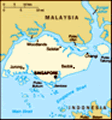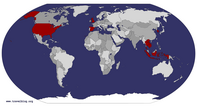Advertisement
Published: February 1st 2011

 Leaving Butterworth
Leaving Butterworth
for Georgetown on Penang IslandMalaysia & Singapore: Just a Taste
After diving in the Similan Islands we were hooked, and we hoped for another opportunity to dip our fins in this part of the world. Our plan for the rest of the trip included visiting Malaysia and Singapore, then jetting to Bali to indulge in resort living sponsored by Aaron’s parents, a gift for our honeymoon. Throughout our travels, Aaron had been in touch with a friend from university who, with his girlfriend, had been working as a dive master in Indonesia. We told them we were coming with hopes to connect. Scotty and Val who had been working on a remote island an hour’s flight from Bali were about to embark on their final live aboard of the season. They encouraged us to join them and said that it would surely be worth our while. With minimal persuasion, we decided they were right; another dive trip was in order. Unfortunately, this change of plans also meant cutting two days off our already short time allotted to Malaysia and Singapore. However, we worked out a plan to maximize our time and see some of the highlights on our way south.
Once we arrived
in Butterworth, Malaysia from Surat Thani, Thailand, we determined that the best way to take advantage of each destination was to take night trains; exploring by day and traveling by night. We pulled into the surprisingly modern industrial town of Butterworth in the early afternoon and took a short car ferry across to the island of Pulau Penang, a former British trading post. Neither of us had any idea what to expect, but we were pleasantly surprised. The bright blue water of the Indian Ocean had not changed when we crossed over from Thailand, nor had the friendly attitude of the people. In fact, when we arrived at the Red Inn Hostel on Love Lane we were warmly greeted by Keke, our incredibly helpful receptionist who spoke nothing short of the Queen’s English. She geared us with a few maps and several suggestions as we embarked into the afternoon.
Pulau Penang, a melting pot of culture and tradition, is most famous amongst tourists for its multitude of food options. According to the Penang Heritage Trust, Penang was established as a British trading post in 1786, and traders and settlers alike came from Europe, the Arab world, India, China, the
Indonesian archipelago, Siam and Burma. The intermingling of these diverse ethnic groups over the last 200 years has resulted in beautifully eclectic architecture, varied lifestyles and beliefs, and the amazing assortment of food. Penang’s capital, Georgetown, is full of these historical communities, thus making it our first days’ exploration. After gorging ourselves on delicious Indian food, we walked it off by visiting the old city and town halls, temples, churches, museums, mansions, and schools. Each street, generally named after the people who settled there, had its own unique personality. Our first day of sightseeing culminated with a meal in an outdoor food court that offered a wide variety of Malay food options as well as live music.
We woke up ready to take advantage of the day, as our overnight train to Kuala Lumpur would leave that night at 11:00. We left our bags with Keke, rented a scooter, and ventured out of Georgetown to see what the rest of Penang Island might be hiding. The beautiful curving road that hugged the coastline was enough to make the trip worthwhile; however, there were several other highlights. Tucked up on the hillside was a tropical fruit farm full of watermelon,

 Our room
Our room
at Red Inn on Love Lanemango, pineapple, star fruit, dragon fruit, jack fruit, and papaya. We enjoyed a freshly prepared plate of our favorites, a cool breeze, and a great view. Continuing on our journey we reached the Air Itam Dam, which provided another spectacular view and a short hike into a monkey filled jungle. Our next discovery was Kek Lok Si, one of the largest Buddhist temples in Southeast Asia. The blend of Chinese tradition and Mahayana Buddhism is evident in its architecture, décor, and Kuan Yin, a towering 30 meter tall bronze statue. Founded in 1890, the immense yet intricate complex continues to grow today due to the affluent and generous Chinese community in Penang.
We arrived back in town just in time to check out the coffee and chocolate factory. White coffee and a variety of chocolates are made in Malaysia, and seeing that these are two of Laura’s favorite things, we had to check it out. We were given an extensive sampling tour of the products and Laura was in heaven! That and our Indian dinner were truly the perfect way to end our time in Penang. We caught the ferry back to Butterworth, boarded the train and waved goodbye
to northern Malaysia.
When we woke up early the next morning we were in Kuala Lumpur. We exited the train into the Central Station and found that the modern terminal linked the railway, monorail, light rail and bus station. For a city of only 1.5 million people, and in Malaysia of all places, we were impressed by the numerous methods of public transportation. With no reservation and the Lonely Planet as our guide, we jumped on the crowded, three car monorail and headed downtown. We found the 8ight Hostel, checked in, and seeing that our time frame was the same as Penang, planned our two days in KL, the nickname for Malaysia’s capital city.
After living in the tropics for many years, we were not surprised or disappointed by the heavy morning rainstorm; instead we used it as an opportunity to catch up on internet and sleep. When the sun came out a little after noon, it was time to hit the town. Despite the variety of transportation methods, KL is quite a walkable city and in just a few hours we were able to cover quite a bit of ground. We visited Chinatown, which is really
just two city streets that are blocked off and full of hawkers. As per usual, there were food stalls, sunglass and souvenir stands, clothing shops, and flocks of tourists. We made our rounds and then headed to the Central Market, another shoppers’ delight, but with one refreshing difference, air conditioning. With the heat, humidity and cultural sensitivity to cover up, we were relieved to be inside. While KL is a progressive cultural, financial and economic center, the country’s Muslim faith encourages women to cover from shoulders to knees even in hot weather.
Needing a place to sit down, we spotted an ever popular fish spa. Fish spas, common in tourist areas of Southeast Asia, are tanks of doctor fish that nibble at people’s feet, eating away dead skin cells and supposedly enhancing circulation. We had been hesitantly avoiding these fish spas throughout our trip for hygienic reasons, but the heat sometimes does crazy things to the mind and it was suggested to us as something we had to try at least once. We sat down, cautiously dipped our feet into the fish infested water, and were taken aback by an immediate swarming ball of noshing fish mouths as each

 Architecture
Architecture
in our neighborhood of Love Laneone jockeyed for position. Aaron giggled uncontrollably, and we could barely contain ourselves from the tickling sensation. Despite our hesitations in the past and feeling a little violated while it was happening, we actually quite enjoyed our fish cleanse, as our feet came out smooth and clean.
One of the coolest parts of Kuala Lumpur besides the ethnic diversity, modern architecture, multitude of transportation methods, and evident middle class, was that the jungle was part of the cityscape. On one side of the street was primary rainforest and the other side were skyscrapers. Massive trees were flourishing out of the concrete sidewalk, draped in vines and cloaked with epiphytic foliage. The KL tower, an architectural structure similar to the Space Needle of Seattle, was completely surrounded by forest and underbrush. On the other hand, the Patronas Towers which were until 2004 the tallest buildings in the world, back up to the man-made beauty of a huge park full of ponds, fountains, and trails. After a full day of walking and site seeing, we returned to 8ight Hostel just in time for the evening rainstorm.
The following day we wandered directionless around the city before returning to the cozy couch
of the hostel to relax for the afternoon. We liked the fact that KL barely noticed us; unlike many places where the local economy survives on tourism, KL is a thriving city and we were able to enjoy it without any hassle. Before we knew it, we found ourselves back in the train station, playing cards, before our night train to Singapore.
We woke up at Singapore’s immigration office and found ourselves in a city atypical to the norm of Southeast Asia. The first place this was evident was in the bathroom. Toilets in most public places along our trail are called ‘squaters,’ a porcelain hole in the ground with grates for standing. Typically, we flush with water from a hand bucket and toilet paper (usually not provided) is thrown in the waste basket. Nevertheless, the toilets in Singapore’s immigration office, and everywhere else, were automatic flush, western-style toilets. Ah, the simple pleasures! The clean and orderly nature of such a modern city can be attributed to the fact that Singapore’s GDP is one of the highest in the world; therefore, by comparison to its neighbors, it seemed expensive. However, after a couple months in Asia, the treat of
eating a gourmet burger and fries while watching ice skating in an air conditioned mall made it worth the price, as it was no more than we would have paid at home.
When asking people about Singapore before we arrived, we had heard mixed reviews. We found Singapore to be a beautiful and intriguing place with an incredible skyline, well groomed parks, stunning architecture, and a diverse mix of residents from all over the world. People were enjoying the exercise trails, outdoor music venues, coffee shops, and the immaculate underground systems complete with high end malls, food courts and a punctual subway. We mostly wandered around staring at the amazing buildings that looked like nothing we had ever seen before. We visited the city kept botanical garden seeking reprieve from the heat and the temptation to shop. Before our evening flight to Bali, Indonesia, we had our last bout with Singapore’s diverse international cuisine and ate a delicious bowl of Vietnamese dry noodles with lemongrass chicken. Yum!
Our time in Singapore and Malaysia had come to an end, but we had squeezed as much out of it as we could have. As the foodies we are, we thought
of our time there as a delicious sampler platter. We were able to taste a variety of flavors, giving us an idea of what we would want to order again. Malaysia and Singapore are more than a default travel destination; they are two places with strong and varied cultures, lovely people, and a ‘flavor’ of their own.
Advertisement
Tot: 0.209s; Tpl: 0.016s; cc: 26; qc: 97; dbt: 0.116s; 1; m:domysql w:travelblog (10.17.0.13); sld: 1;
; mem: 1.3mb






















Andel
non-member comment
Sounds like fun (and tasty, too)!